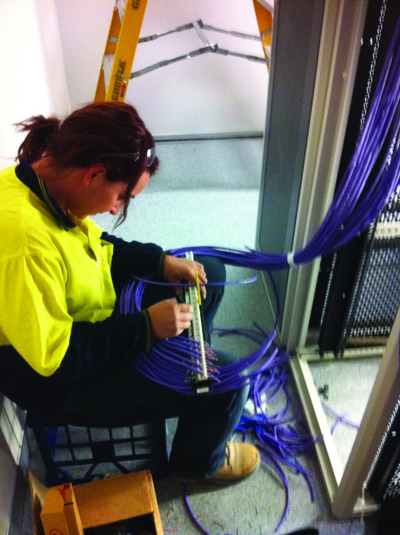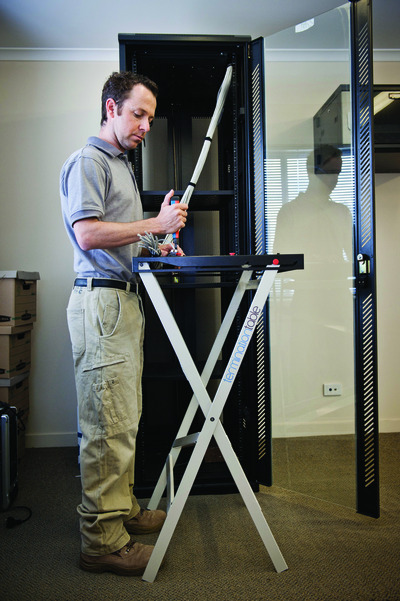Reducing the risk for comms cablers
Thursday, 04 April, 2013
As the world adapts to recent technological advancements in readily deployable virtualisation, cloud computing, CoLo and enterprise networks, the migration towards 40 Gbps copper and 100 Gbps fibre cabling infrastructure will see the daily work practices of telecommunications installers undergo a drastic change.
Installers of highly complex cabling projects have seen rapid advances and developments in termination technologies over the last few years, but no improvement to their typically cluttered and uncomfortable working environment or to the repetitive manual handling of cables, jacks, patch panels and punch-down tools.
Typical work practices
Manual patch panel termination tends to be a highly repetitive task, with installers often on site for weeks or months and generally left to devise their own platform and workspace. This situation can be made all the more difficult due to space constraints in comms rooms and the shifting landscape that is typical of a building site.
It’s not uncommon for an installer to set up a patch panel while sitting on a chair or milk crate, fixing the panel to the cabinet and terminating either from the inside or in front of the cabinet. Cabinets can contain up to 45 patch panels. Technicians are required to remain in positions for up to 2 hours while working on one panel while they attach the electrical conductors. This process is repeated for all the panels in the cabinet, so potentially 8640 electrical conductors are attached by one technician to complete one cabinet.

The wiring associated with the tasks is contained in a bundle and each wire requires termination. This action involves:
- stripping the ends of the wire with a cable jacket stripper;
- positioning the exposed wire over the connection jacks;
- ensuring that the wires are correctly aligned with the connectors and;
- a punch-down to ensure proper connection through the panel to the electrical wiring.
In some cases, the installer will terminate on a makeshift work bench made from whatever can be found on-site: cable boxes, cable reels and drums.
In addition, work may be performed in work environments that have poor ambient conditions such as:
- low levels of illumination for the fine detailed work required to perform the work;
- poor airflow reducing air quality that increases the discomfort;
- temperatures at extremes due to lack of air conditioning in the work environment; and
- poorly designed workspaces that restrict movement or force workers to maintain constrained body postures for prolonged periods of time.
What are the OHS risks?
The repetitive nature of the tasks, coupled with some fairly primitive working conditions, mean that neck, shoulder and back pain is not uncommon among telecommunications technicians. A survey of approximately 30 telecomms technicians from the Canberra/Queanbeyan region, conducted by Health and Safety Consultant Glenda Snoxall of Safety Key Solutions in 2011, endeavoured to identify the key areas of body discomfort. The survey results showed that during the processing of data cable termination, a staggering 75% of respondents suffered from neck pain, 67% from shoulder pain and 63% from lower back pain.
The Australian National Code of Practice for the Prevention of Musculoskeletal Disorders (2007) sets out practical guidance on how to reduce the risks of musculoskeletal disorder (MSD) from manual tasks undertaken at work. The code was designed for use by employers, owners of premises, OHS professionals, and designers, manufacturers and suppliers of items used in any workplace.
The code calls for control over risk of MSD through elimination or reduction in the number of repetitive actions, awkward postures, sustained postures and movements required over time to perform a manual task, as well as to reduce the amount of time that a user needs to spend carrying out manual tasks associated with an item being designed, supplied or manufactured.
According to the code, as the pace of work increases, postures or movements become more repetitive, which means the same muscles are being used continuously. The speed of movement can also increase the risk of injury. Posture affects the muscular effort needed to perform a task and how quickly muscles fatigue. Posture and movement are particularly important when forceful and/or repetitive tasks are performed or postures are held for prolonged periods.
Repetitive awkward postures are those positions where the whole body, or parts thereof, is not in a normal or neutral position. As a joint moves further away from its normal position, more muscular effort is needed to achieve the same force and where these postures are assumed repetitively, the risk of MSD increases.
Sustained awkward postures are those awkward positions where the whole body or parts of the body (that are not in their normal position) are held for more than 30 seconds at a time. Repeated or sustained movement occurs when the task involves performing the same actions over and over.
In essence, the milk-crate scenario described earlier encompasses all of these risk factors combined; prolonged repetitive movement in both sustained and awkward postures leaves many comms cablers open to the threat of ongoing MSD pain.
Addressing the issue
David McHarg, a former communications technician and owner of Tech Innovations, saw an obvious gap in the market and an opportunity to improve working conditions for this industry group. He worked with OHS consultant Glenda Snoxall, ACT Safety Regulator and Ergonomist Richard Siddell and Peter McKay of Industrious Design to develop a solution. The team worked together initially to develop an in-depth risk assessment and report in accordance with the code of practice.
They then went on to design a product that provided a better working platform, addressing the key features required from a health and safety aspect and ensured compliance with the manual handling code of practice, which covers: working height, tool arrangement and distance, weight, carrying method. The TechTable was born: a slimline, portable, lightweight and sturdy work surface for comms technicians. Market input was sought, particularly on size, weight, tool tray size and padding requirement.
The TechTable allows technicians to perform tasks at waist height and to easily rotate between standing and seated positions. It provides a stable and comfortable platform and is height adjustable, allowing technicians to terminate at their ideal height.

Improving installer efficiency and performance
Tech Innovations claims that, while the TechTable has eliminated or reduced many of the identified manual handling risks associated with cable installation, testing has also proven it to increase an installer’s productivity by up to 24%. Moreover, it is designed for easy daily transport inside a padded carry bag and the set-up time is less than one minute. The dimensions are designed to suit tight-fit positions in cluttered computer rack environments, telecommunications rooms and data centres.
The apparatus allows technicians to temporarily mount a patch panel onto the table for faster loading and termination consistency. As this procedure was previously carried out inside the cabinet, the technician was constrained to a working compound with an average width of only 60 cm. This is no longer the case. Cables can be positioned into a supplied cable feed for easy and accurate cutting and they can be tied with assistance from incorporated cable tie assembly points.
Prior to being commercially released, TechTable was trialled by a number of comms and electrical service companies. Feedback suggested that the apparatus not only offered a much more comfortable position than traditional installation methods, but suggested that far greater accuracy and speed were achieved and that forming of cables was neater when using the device.
While vendors constantly improve jacks, plug and play solutions, rapid tools and patch panels to promote greater efficiency, this is predominantly aimed at improving production values and seldom, if ever, focuses on the installation procedure itself. It’s nice to see an Aussie innovation that addresses the problems installers are exposed to on daily basis.
Thought Leaders 2025: Miroslav "Miki" Vuruna
Net zero, geopolitical risks and cybersecurity: Warren & Brown's Engineering and R&D...
Powering data centres in the age of AI
As data centres are increasingly relied upon to support power-hungry AI services and...
Smart cities, built from scratch
With their reliance on interconnected systems and sustainable technologies, smart cities present...




